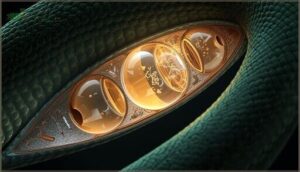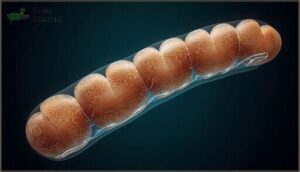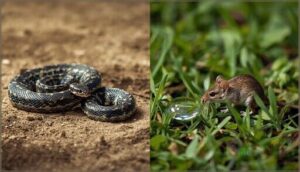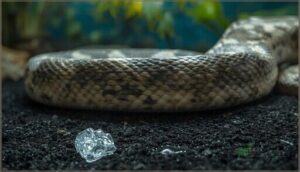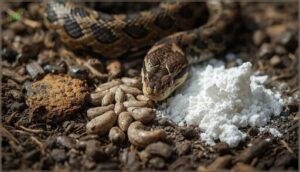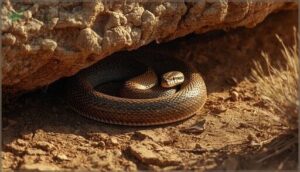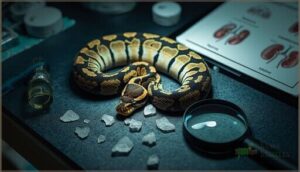This site is supported by our readers. We may earn a commission, at no cost to you, if you purchase through links.
Spotting a snake’s trail in the wild, you might expect droppings—maybe a little puddle. But snakes play by their own rules. Their pee looks nothing like the yellow liquid you picture; instead, it shows up as a chalky white smear, perfectly engineered for a life with scarce water.
This clever twist in evolution lets snakes thrive where thirst never really quits. Understanding how snakes pee sheds light on a waste process that’s wildly efficient and unlike anything you’ll see in a mammal.
Peek beneath the scales, and you’ll discover a secret built for survival.
Table Of Contents
- Key Takeaways
- How Do Snakes Pee?
- Snake Urinary System Anatomy
- Difference Between Snake and Mammal Urination
- What is Uric Acid in Snakes?
- How Snakes Eliminate Waste
- Identifying Snake Urates and Droppings
- Environmental Factors Affecting Snake Pee
- Water Conservation in Snake Excretion
- Common Urinary Health Issues in Snakes
- Maintaining Urinary Health in Pet Snakes
- Frequently Asked Questions (FAQs)
- Conclusion
Key Takeaways
- Snakes pee through the cloaca as a chalky white or pasty urate, not as liquid urine, which helps them conserve water in dry environments.
- Their kidneys are specialized to produce uric acid, creating a semi-solid waste mixed with feces for maximum efficiency.
- Changes in a snake’s waste—such as texture, color, or odor—can indicate hydration or health issues and are influenced by diet and habitat conditions.
- Proper hydration, a balanced diet, and good enclosure hygiene are key for maintaining urinary health in pet snakes.
How Do Snakes Pee?
Curious about how snakes pee? You might be surprised by the unique way their bodies handle waste. Let’s take a look at what happens, step by step.
Definition of Snake Urination
Snake urination is more of a one-stop shop than a tidy separation of functions. Instead of a direct liquid stream, snakes create a paste-like mix—mainly uric acid—packed into their urate. Their cloaca function combines waste evacuation with reproductive roles.
Urine composition shifts based on hydration influence, making excretion highly efficient for reptile waste elimination in their world. Understanding the importance of thematic statements can help in analyzing complex biological processes.
Overview of Excretion Process
For reptiles like snakes, excretion is a simplified affair. Everything—from waste composition to urate formation—travels through the snake digestive system and ends at the cloaca. Here’s the flow:
- Food is digested.
- Kidneys filter waste.
- Urates form as a dry paste.
- The cloaca releases combined waste and urates, making Snake Excretion uniquely efficient in water conservation.
Understanding the process of waste removal is similar to evaluating study quality assessments in scientific research.
Snake Urinary System Anatomy
Before you can spot changes in your snake’s health, it helps to know how their insides work.
Let’s look at what makes up the urinary system in snakes. Here’s what you’ll find inside.
Role of The Cloaca
Tucked just before the tail, the cloaca is your snake’s one-and-only gateway for waste, reproduction, and more—a true model of Excretion Integration in Reptile Anatomy. This chamber carefully blends feces, urates, and sometimes eggs, so every exit event reflects the snake’s Hydration Influence. If waste appearance changes, the cloaca becomes a key Diagnostic Indicator.
| Cloaca Anatomy | Excretion Integration | Urate Expulsion |
|---|---|---|
| Multi-use cavity | Blends waste streams | Semi-solid form |
| Three chambers | Digestive/urinary/repro | Influenced by hydration |
| Opening location | Reptile-exclusive | Waste with urates |
| Diagnostic clues | Essential in care | Monitors health |
| Species variable | Linked to habitat | Affected by diet |
Structure of Snake Kidneys
When you peek into reptile anatomy, you’ll find that their kidneys aren’t like our bean-shaped organs. Instead, snakes use elongated, lobulated metanephric kidneys. Here’s how that looks in action:
- Stretched-out design
- Multiple kidney lobes (Kidney Lobulation)
- Streams of nephrons (Nephron Arrangement)
- Sharp focus on uric production
- Everything lined up for maximum water savings
Snake biology at its most efficient.
Ureter Function in Snakes
Picture a relay race inside your snake—Ureter Morphology is the baton. Here, urine runs a muscular route from the kidneys to the cloaca, carrying uric acid-rich fluid along the way.
This efficient Kidney Drainage process aids Water Conservation, letting urates mix with feces just before Excretion. It’s Cloacal Mixing, refined for reptiles that thrive where water is scarce.
Difference Between Snake and Mammal Urination
Snakes and mammals handle “peeing” in very different ways. The way each group manages waste comes down to anatomy and evolution. Here’s what sets them apart.
Combined Excretion Vs. Separate Passages
Ever wondered why snakes don’t pee like mammals? Instead of two exits, snakes use one: the cloaca. This single opening pulls double duty, combining everything—urates and feces—into one efficient discharge.
It’s a clever solution, handed down from reptilian ancestors, driven by evolutionary pressures for water conservation and waste efficiency. That’s the cloaca advantage in action.
Evolutionary Adaptations
When you look at snakes through an evolutionary lens, you see a masterclass in water budgeting. Their kidney specialization and uricotelic shift—favoring uric acid for excretion—allow survival where water is scarce.
Renal loops and unique ureteral muscle arrangements fine-tune how waste is managed, marking a clear split from mammals. These evolutionary adaptations keep reptiles thriving in harsh places.
What is Uric Acid in Snakes?
Snakes handle waste differently than most animals, and uric acid plays a central role. If you’ve ever wondered what’s actually in snake urine or why it looks so unique, you’re not alone.
Here’s what you can expect regarding how snakes get rid of waste in their enclosures.
Composition of Snake Urine
Snake urine isn’t liquid like you might expect—it’s a chalky blend crafted for survival. Thanks to uric acid, snakes produce a concentrated, semi-solid paste that saves precious water. Their kidneys filter nitrogenous waste into urates, which mix with feces in the cloaca.
Typical features include:
- High uric acid content
- Mildly acidic cloacal pH
- Minimal liquid
- Efficient water conservation
Why Snakes Excrete Uric Acid
Think of uric acid as your snake’s silent lifesaver—it allows the body to manage nitrogenous waste with barely a splash to spare. This clever excretion method, called uricotic evolution, makes snakes masters of water conservation. Living proof of reptile biology’s genius, their kidneys turn waste into urate, perfectly suited for dry habitats and smart waste management.
Uric acid lets snakes conserve water so efficiently that they thrive in dry habitats by turning waste into nearly dry, harmless urate
| Benefit | Adaptation | Result |
|---|---|---|
| Water Conservation | Uricotelic Evolution | Less Liquid Lost |
| Arid Adaptation | Kidney Function | Drier Environments |
| Efficient Excretion | Uric Acid Production | Fewer Kidney Stones |
How Snakes Eliminate Waste
Snakes have a unique way of getting rid of waste, combining everything in one go. Understanding how this works can help you spot what’s normal and what’s not.
Here’s what you can expect regarding their waste habits.
Combined Discharge of Feces and Urates
Picture the cloaca as a one-stop exit—here, feces and urates mingle into a single discharge composed mostly of uric acid for excellent water conservation.
This combined excretion strategy isn’t a random quirk; it’s an evolutionary advantage. Urate composition shifts with environmental impact, ensuring snakes save moisture and maintain health, with discharge frequency reflecting both diet and hydration status.
Frequency of Excretion
Frequency of excretion isn’t one-size-fits-all—species variation, diet, age, and even the seasons shape how often urine, uric acid, and feces make their way out. You might witness:
- Weekly defecation after a large meal
- Daily urate release in hydrated juveniles
- Slowed excretion in cooler months
- Noticeable changes with health shifts
Every snake’s rhythm is unique.
Identifying Snake Urates and Droppings
If you’re curious about what snake waste looks like, you’re not alone. There’s actually a lot you can learn just by knowing what to look for in their droppings and urates.
Here’s how you can spot the differences and what each type can tell you.
Appearance and Texture
Urate consistency speaks volumes about your snake’s habits. Expect a chalky, crumbly pellet—often cool to the touch—with hints of crystal formation nearly fused into the white urate. Feces appear log-like and soft, paired with any liquid presence, which is rare but possible in hydrated conditions. Examine for abnormal appearances; odd textures can flag health swings or dehydration.
| Feature | Typical Appearance | Possible Variations |
|---|---|---|
| Urate Consistency | Chalky, crumbly, dry pellet | Pastier if environment is wetter |
| Crystal Formation | Small, gritty textures | Larger, irregular shapes |
| Liquid Presence | Minimal, mostly dry | Noticeable after heavy hydration |
Color and Odor
After texture comes the visual and sensory test: color and smell. Urate coloration often gleams white, but diet or hydration shifts can tint it pale yellow or chalky. Odor intensity usually sits low—snake pee isn’t musky like mammal urine, unless dehydration or infection lurks.
Keep an eye on these five telltale signs:
- White, powdery uric acid
- Subtle, antiseptic scent
- Tart note signals standing moisture
- Yellow tint hints dehydration
- Strong odor means health monitoring needed
Environmental Factors Affecting Snake Pee
Regarding snake health, their environment plays a big role in how they pee. Things like temperature and humidity can shape everything about waste habits.
Here’s what you should look for in setting up the right kind of enclosure.
Impact of Temperature
Think of Temperature as a dial for your snake’s Metabolic Rate. When it’s warm, everything speeds up—Excretion Frequency rises, Renal Bloodflow increases, and urates come out softer. Cooler temperatures slow processes down, making urates thicker and raising Dehydration Risk.
For Reptiles, Osmoregulation is all about striking a balance; the wrong conditions stress Snake Biology and Physiology.
Importance of Humidity
When you manage humidity for your pet snake, you’re setting the groundwork for healthy kidneys and balanced excretion. The right humidity’s impact reaches deep— it helps maintain hydration status and keeps urate concentration in check. Miss the mark, and infection risks or uric acid blockages climb. A stable environment matters for reptiles.
- Promotes efficient uric acid excretion
- Aids proper hydration
- Lowers infection risks
- Prevents concentrated urate blockages
- Maintains pet snake wellness
Water Conservation in Snake Excretion
Snakes are experts at holding onto water, even in the hottest, driest places. Their bodies have clever ways of making every drop count.
Here’s what you’ll want to know about how they pull it off.
Adaptations for Dry Environments
Ever wonder how reptiles survive bone-dry landscapes? Desert species have fine-tuned Water Conservation, turning waste into nearly dry uric acid crystals.
Their kidneys mainline osmoregulation, producing super-concentrated urine while minimizing cutaneous loss. Fewer meals mean longer fasting—a neat trick that lets snakes go weeks between excretion.
With these adaptations, even the driest sands can’t out-thirst a well-adapted snake.
Benefits of Uric Acid Production
Efficiency is the heart of Water Conservation in reptiles. When your snake’s kidneys convert waste into uric acid, you get more than just dry droppings. This process slashes water loss by nearly 70%, offering impressive Arid Adaptation.
Urate Stability keeps crystals harmless, while strong Kidney Function means less frequent—yet safer—excretion. That’s true Waste Reduction in action.
Common Urinary Health Issues in Snakes
Just like us, snakes can run into trouble with peeing and staying healthy. If something isn’t right, you might notice changes in their behavior or what they leave behind.
Here are a few common issues to watch for in your snake’s urinary health.
Signs of Dehydration
When dehydration creeps in, your snake’s skin elasticity fades, and its once-bright eyes become noticeably sunken. Urate consistency shifts—drier, more compact pellets signal kidneys working overtime to conserve water.
Lethargy and a reduced appetite often follow. Since reptiles rely on uric acid for waste, changes here are your first cue for supporting reptile health.
Urinary Tract Infections
What if your snake starts acting “off”—could it be a UTI? In reptile health, urinary tract infections are surprisingly common, especially in snakes kept with poor humidity or chronic stress.
UTI prevalence in reptiles links to bacteria like E. coli, with risk factors ranging from dehydration to injury. Diagnostic imaging clarifies infections; prompt, customized antibiotic therapy can preserve animal health and prevent kidney stones.
Constipation and Blockages
When waste gets stuck in the system, your pet’s health can take a nosedive. Impaction risk factors for snakes spike with poor hydration and limited substrate variety. Watch for:
- Sluggish, infrequent feces
- Swollen mid-gut or cloacal region—key blockage sites
- Signs of dry-season stress
- Radiographic validation of constipation
- Post-masting dehydration risks
Mind your waste management for top animal health.
Maintaining Urinary Health in Pet Snakes
Caring for a snake’s urinary health is about creating the right environment and habits. Small changes can make a big difference in keeping your pet healthy. Here’s what to focus on next.
Proper Hydration
With Pet Snake Care, water availability isn’t just a box to check. It’s the backbone of Reptile Care—turgor pressure keeps your snake’s skin supple, and proper substrate moisture aids shedding frequency.
Watch for Hydration indicators like alert behavior, regular Uric Acid output, and easy sloughing, all signaling healthy Osmoregulation. In Snake Care and Feeding, hydration always comes first.
Diet Considerations
Once you’ve nailed hydration, your next smart move is watching what they eat. Prey Hydration matters—a thawed rodent offers water, while Feeder Protein Levels ramp up Uric Acid Management.
Feed too often, and Waste Analysis gets interesting. Captive Diets shape everything about Snake Pee and digestion. Think of it as tuning Reptile Biology and Anatomy, one meal at a time.
Enclosure Cleanliness and Hygiene
Smart substrate choice makes all the difference—think of it like picking the right shoes for a muddy day. Pair that with regular waste removal, attentive water quality checks, and clear sanitization protocols, and you’re setting the scene for odor control and thriving reptile health. Aim for this combo every week:
- Swap out soiled substrate.
- Spot-clean daily.
- Disinfect touchpoints.
- Refresh water.
Frequently Asked Questions (FAQs)
Do snakes poop and Pee?
Think of a snake’s bathroom break as a multitasking act—both pee and poop exit together, thanks to their cloacal function.
This combined waste features a mix of feces and urate composition, with frequency changing alongside diet or dehydration effects.
Why do snakes poop and Pee out of the cloaca?
Snakes use the cloaca for both poop and pee because it’s an efficient, evolutionary shortcut. This single opening lets them combine waste—feces and uric acid—saving water and space.
Cloaca advantages boost excretion and waste management, blending efficiency with survival.
How do snakes urinate?
Picture a snake with its all-in-one excretory system: no grand bathroom privacy, just business through the cloaca. After kidney filtration, uric acid and waste blend into a chalky, semi-solid urate composition—delivered by cloacal discharge, minimizing dehydration.
What happens when a snake Pees?
When a snake pees, you’ll notice a pasty white or chalky urate—thanks to their unique urate composition and excretion mechanics.
Their cloacal discharge combines concentrated waste, with water reabsorption tightly controlled by the excretory system.
Where do snakes urinate & defecate?
You’ll find that urination and defecation happen simultaneously in one spot—a single opening called the cloaca.
This essential structure in reptile anatomy manages every stage of the excretory system, combining urate composition and fecal waste in each discharge.
Do snakes Pee liquid?
Imagine spotting a chalky, white smear beside a snake’s droppings—don’t mistake it for liquid. Unlike mammals, snake pee is pasty, made mostly of uric acid and urates. Hydration, diet, and excretion frequency shape its final form.
Why is snake pee hard?
Snake pee isn’t liquid—it’s usually a chalky, hard mass because snakes excrete uric acid as crystals.
This unique waste composition, called cloacal discharge, helps conserve water. Their kidney function produces urates instead of liquid urine.
What does snake urine look like?
Like a drop of chalk on old slate, urate color in snake pee ranges from white to pale yellow, with a pasty or powdery urate texture. The odor profile is faint, and freshness indicators include slight translucency—abnormal urates can signal health issues.
How do snakes go to toilet?
When it’s time for waste elimination, you’ll see snakes release both feces and urates together in one go via the cloaca.
Excretion frequency depends on metabolism, with dehydration effects and urate composition signaling possible kidney stones.
Do snakes urinate and poop?
Yes, snakes urinate and poop, but do things differently from mammals. Using the cloaca, snakes expel both feces and uric acid together.
Their semi-solid waste, known as urates, reflects hydration impact and unique excretion systems.
Conclusion
Imagine if your bathroom routine doubled as proof of your evolutionary prowess—snakes have mastered that art. Their chalk-white urates are like nature’s clever memo: conserving water means outsmarting thirst.
Next time you stumble upon a chalky trail, remember, you’ve just witnessed innovation in action. If you’ve ever wondered, “how do snakes pee,” now you know: their answer is efficient, subtle, and uniquely reptilian.
It’s a lesson in adaptation, hidden quietly beneath the scales, marking survival with every drop.
- https://mypaperhelp.com/blog/research-paper-topics
- https://pmc.ncbi.nlm.nih.gov/articles/PMC9655144/
- https://academic.oup.com/biolinnean/article/133/3/910/6261016
- https://vcahospitals.com/know-your-pet/snakes-diseases
- https://subscribe.wordpress.com/memberships/?blog=173610046&plan=1568&lang=en-gb&pid=1138&redirect=https%3A%2F%2Fonurbicycle.wordpress.com%2F2020%2F05%2F07%2Fsnake-poop-wee


